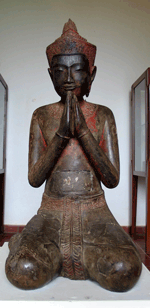 Material: Wood
Material: Wood
Dimensions: H: 91 cm
Date: XVIth century
Provenance: Angkor Wat (Siem Reap)
Collection: National Museum of Cambodia,
Phnom Penh
According to Buddhist beliefs, birth and rebirth are the sufferings of living beings. In this image, the worshiper is paying her respect to the glorious one for liberating her future life from the Samsara (cycle of life) toward Extinction (nirvana) by a gesture called ‘sampeah’ in Khmer or añjali in Pali (hands joined).
Her mukuta (head-cover) is represented at the top by a stylised lotus bud. She is known as Tep Pranam in Khmer (Tep means Deva, Pranam means añjali). Tep Pranam is only used for a female divinity with hands joined. This praying figure sits in ‘pleated legs’ position represented by the legs placed under her on the left or right side.
This worshiper made in wood ‘Kakoh’ protected by lacquers and paints in different layers and highlights the ‘can kbin’ style of dress.
Perhaps a sculptor’s mistake, the central pleat of her ‘sampot’ (skirt) passes over the scarf. Above this point, a cavity carved into the stomach was used to keep sacred deposits; small Buddha figures, relics or palm-leaf texts to make the statue a sacred object .
A slightly flat nose, thick lips, joined arched eyebrows express her beauty. Because of her typically Khmer facial expression, we consider this a masterpiece of post-Angkorian sculpture.
A slightly flat nose, thick lips, joined arched eyebrows express her beauty. Because of her typically Khmer facial expression, we consider this a masterpiece of post-Angkorian sculpture.
Note that in Khmer classical art, the female divinities (except in bas-reliefs) never wear the ‘sampot can kbin’ . This Tep Pranam proves the continuation of Khmer tradition for wearing the ‘sampot can kbin’, from the pre-Angkorian to post-Angkorian periods. During the post-Angkorian period the sampot can kbin was used not only by men, but for both sexes.
Source:http://www.cambodiamuseum.info/en_collection/wooden_object/tep_pranam.html
Source:http://www.cambodiamuseum.info/en_collection/wooden_object/tep_pranam.html
0 comments:
Post a Comment